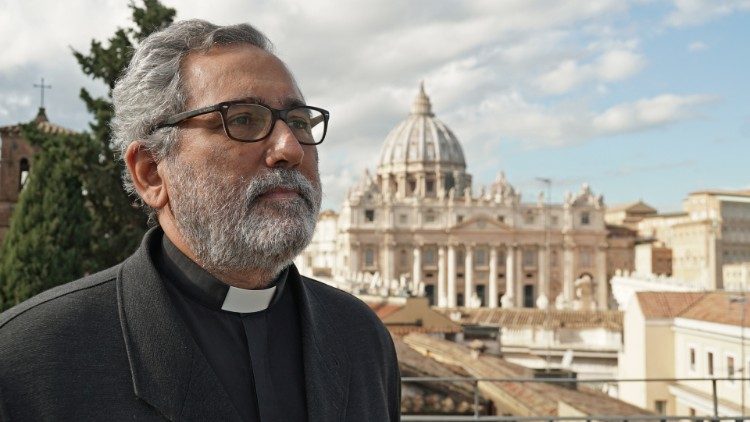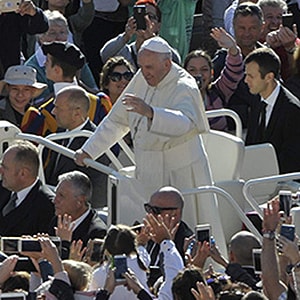
Fr. Guerrero: Peter's Pence supports the mission of the Church
By Andrea Tornielli
"It is important to collaborate because we cannot think that the mission of the Church can be sustained without the contribution of the faithful. The proclamation of the Gospel throughout the world, with all that it entails, presupposes a support structure."
On the eve of the Peter’s Pence collection, the Prefect of the Secretariat for the Economy, Jesuit Father Juan Antonio Guerrero Alves, explains in this interview how the funds collected are used: charitable interventions and the contribution for the Pope's service to the Church throughout the world.
Q: Father Guerrero, many people ask questions and want to know about Peter's Pence, after so much contradictory news.
First of all, I would like to say that people have the right to know how we spend the money that is given to us. Sometimes contradictions come from lack of knowledge, which in turn can also come from lack of transparency. When I began my service as Prefect of the Secretariat for the Economy, the Holy Father asked me to pay special attention to transparency. During this time in the Secretariat for the Economy, I have tried to share with the faithful the economic data of the Holy See that I know and that seemed relevant to me.
Q: What, then, is the purpose of Peter's Pence?
We speak of the Pope’s charitable outreach, and that’s what it is. Charity, of course, is offering donations to local churches, institutions, families or people in need. But it's not just money that comes to Rome and that the Vatican distributes to different parts of the world for charitable works. This is one of the objectives of Peter's Pence. That is, there are donations for Peter's Pence that come in and are immediately distributed to places where there is need. To give an example of what I know from first-hand knowledge: in 2021, ever since it has been under the supervision and control of the Secretariat for the Economy, until now, the Peter’s Pence collection has received 21 million euros in donations (there may be some more from last year that arrived late). Of these, 8 million euros have been distributed for evangelization or social projects in support of churches in need, mainly in countries in Africa, Asia and Latin America. Developments in the first half of the year, when more direct donations are made, should be similar to previous years.
Q: However, Peter's Pence is not only used for charitable works....
In fact, it is also important to explain and understand that part of the Pope's charity concerns his mission of unity in charity, which he carries out through the dicasteries and institutions of the Roman Curia at the service of the universal Church. Part of the budget of some dicasteries is intended to help Churches in need and in difficult human situations, but this is usually not the main part of their mission, which is rather to offer their specific service to the universal Church. These institutions of the Curia have no income of their own, and generally do not receive financial compensation for their services. Let us think of the service of the unity of the faith, the liturgy, the Church's courts, the Pope's communication, the care of the patrimony received over the centuries in the Library or the Archives, where important documents of the history of humanity are preserved, the papal representations around the world, etc. These services rendered to the universal Church do not generate income and are partially financed by the Peter's Pence collection.
Q: There is often talk of a Peter's Pence fund that has millions. Can you explain why part of the collection is saved and why a fund was established?
Regarding saving and the fact that there has been a Peter's Pence fund in existence for decades, one basic explanation is that when significant, extraordinary donations come in, for example, a large bequest for the Pope's mission, it does not seem prudent to spend it immediately during the year. It can be used at a later date, for when there is more need, or a fund can be created to support long-term projects over time. Saving in the years when you need it least, for when you need it most, is something sensible and prudent. Of course, these savings must be administered with care, according to the principles of the Church's social doctrine, with the prudence of a good father of a family, and with the knowledge that what we receive each year does not cover all the expenses of the mission.
Q: Did the economic downturn caused by the pandemic affect the latest Peter's Pence collection much?
We have already noticed a decrease in the collection over the past few years. Between 2015 and 2019, the collection decreased by 23%. In addition to this decrease, in 2020, the first year of COVID, Peter's pence revenue was 18% lower. The pandemic-related crisis is likely to be felt again this year. Some donations received have a specific destination, others are offerings for the Holy Father in general. In 2019 the Peter's Pence collection was 53.86 million euros, distributed as follows: 43 million in the general fund of the Peter's Pence collection and 10.8 million with specific destinations for situations of need in the Church and the world. In 2020 the collection amounted to 44.1 million euros distributed as follows: 30.3 million for Peter's Pence collection and 13.8 million for specific destinations.
Q: Can you clarify what you mean by "specific destinations"?
When we talk about specific or targeted destinations, we mean talking about targeted donations, for example, for the construction of churches in less developed countries, social services such as hospitals for children or support for schools in impoverished areas, support for the presence of religious communities in areas that are difficult due to violence or poverty, formation of pastoral workers, etc. Social projects, in these destinations, take the lion's share. If we receive a donation with an already defined purpose and accept it, we respect the will of the donor. On the other hand, in the budgets of some dicasteries, in this year of lower income, expenditures have increased to support churches in difficulty, as in the case of the Dicastery of Integral Human Development, which has increased its expenditures to support some of the most difficult realities this year.
Q: Father Guerrero, why is it important to collaborate? Why donate to Peter's Pence?
It is important to collaborate because we cannot imagine that the mission of the Church can be sustained without the contribution of the faithful. The proclamation of the Gospel throughout the world, with all that it entails, presupposes a support structure. The Church has always lived this way. As Pope Francis said in his message to the Pontifical Mission Societies, the Church has always kept going thanks to the widow's offering, and to the contribution of countless people who are grateful for the gift of faith and who give what they can. Already at the beginning of the Church, Saint Paul promoted a collection in favor of the Church in Jerusalem (cf. 1 Cor 16:1). In his letters, the apostle gives some criteria centered on the principle of communion of the various communities of the one Church.
Q: The Peter’s Pence fund has been often mentioned in the media in the last two years because of its investment in the fund that owns the Sloane Avenue building in London: was a lot of money lost in this operation?
This is a painful story. It is always true that in investments sometimes you gain and sometimes you lose. But if there were irregularities, we must understand them and punish those responsible. Peter's Pence investments were traditionally put together with investments from other funds assigned to the Secretariat of State. It was not easy to say that this part, these shares or this building belongs to Peter's Pence and this belongs to other funds. As I was saying, the Holy See has embarked on a path of transparency and this path also includes the clarification of unclear events. What can be said, meanwhile, is that the devaluation and losses regarding the building in London did not weigh on the Peter's Pence fund but on other funds held by the Secretariat of State. I believe this was done out of respect for the donations of the faithful. This was decided when the amount of each fund's coverage of the losses was made.
Q: A lot of numbers have been written, there has been talk of about 800 million euros? Can you tell us how much money the Peter's Pence fund actually has?
Talking about 800 million euros... seems like fantasy to me! In the accounts that I have seen, the net worth of all the funds of the Secretariat of State over the last ten years has always been well below this amount. The Peter's Pence fund in 2015 was 319 million euros. In recent years, it has spent an average of 19 million euros more than it has collected. The Peter's Pence fund had, as of December 31, 2020, about 205 million euros, some of it in not very "liquid" investments, including the building in London. The Obolo fund has been decapitalized in recent years due to the expenses of the Curia's dicasteries, which needed more than what was being collected. It is obvious that this can no longer continue.
Q: Who manages the Peter's Pence funds today?
Until last year, Peter's Pence donations were collected, managed, and administered by the Secretariat of State. In December 2020, a Motu proprio was issued by which the funds were transferred to APSA. As for the collection, a large part of it takes place in the churches during the collection on the feast of St. Peter, June 29. Last year in many countries, due to the closure of churches for the pandemic, the collection was moved to October 4, the feast of St. Francis. This year it will take place again on St. Peter's Day. Individual churches send the collection to their dioceses, and the dioceses send it to the nunciatures, which in turn send it to Rome. Many of the faithful donate directly through the web page or by direct transfer to IOR accounts. As for the Motu proprio of last December, it responds to the need to ensure maximum transparency, the separation of functions in the unity of the mission. The Holy See is one. We are all at the service of the mission of the Pope, the Successor of Peter. The management and administration of the fund and of the proceeds is now the responsibility of APSA, although, naturally, the Secretariat of State, which through the nunciatures knows best the needs of the local churches and of countries, is the one that designates the projects to be helped. The control of income and expenses is the responsibility of the Secretariat for the Economy, where the Office of Peter's Pence is now located. We hope to be able to give as soon as possible a precise account to the faithful of everything related to the Peter's Pence collection, starting with the income and expenses.
Thank you for reading our article. You can keep up-to-date by subscribing to our daily newsletter. Just click here








